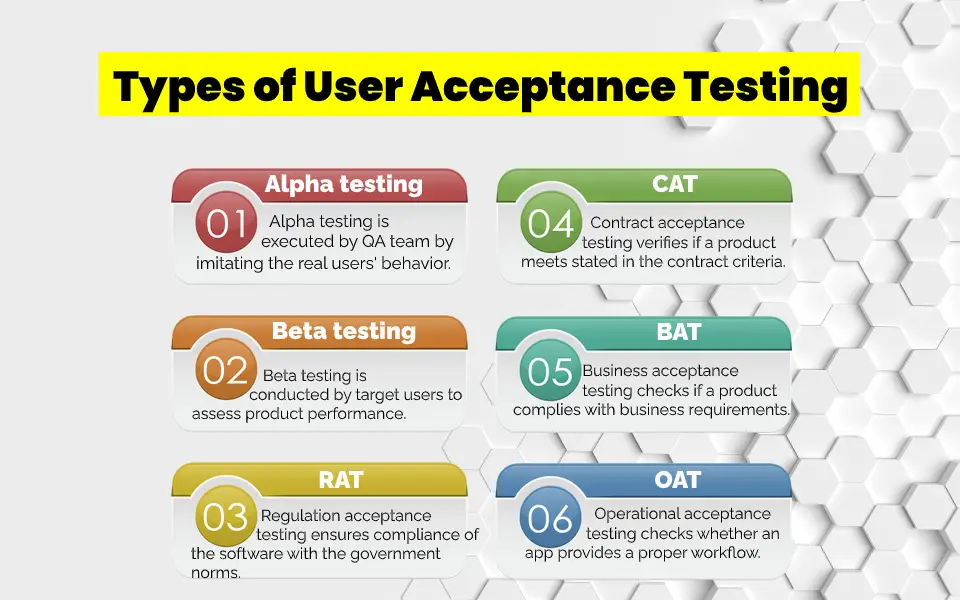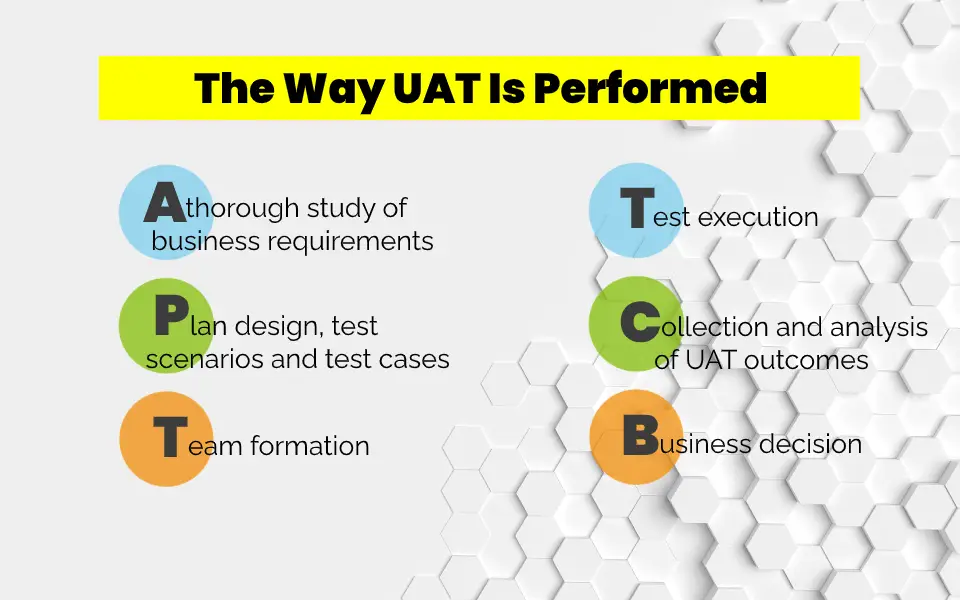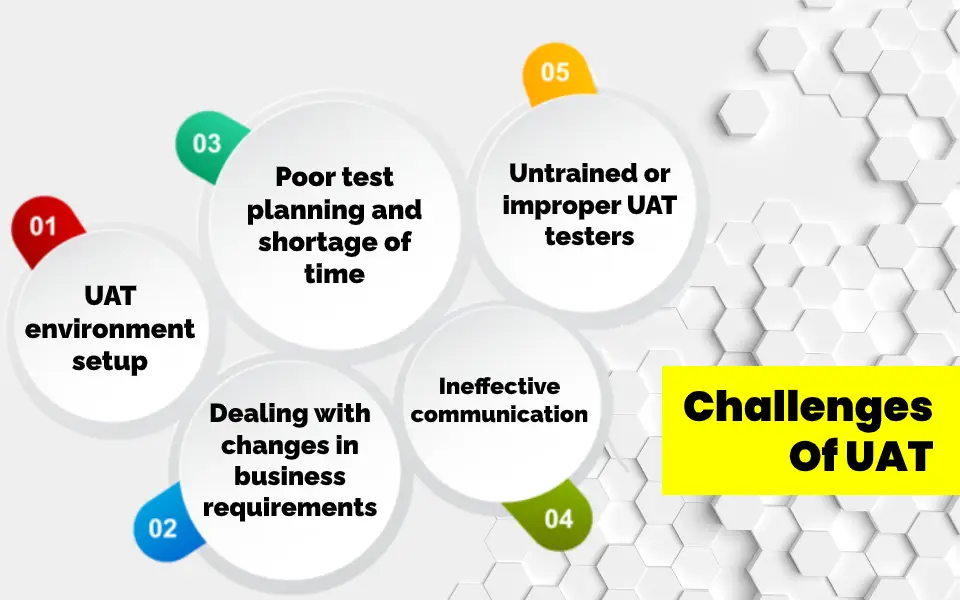11 minutes to read
User Acceptance Testing - When & why UAT is needed and how to make it more effective


Chief Technology Officer
The main mission of a project team is to hit a market with an excellent product and make all users delighted. To ensure the first-class quality of an application, QA experts conduct a wide variety of tests to check all the ins and outs of the software and not leave out any aspect. Still, even the effort of the whole QA team is not enough. To make sure that every single user will be pleased with an application, people outside the internal QA team are engaged in UAT or User Acceptance Testing execution. If you find yourself intrigued, go on reading to find out the peculiarities of UAT execution.
What Is User Acceptance Testing?
Traditionally, it makes sense to start with giving a definition of a term. In a nutshell, UAT is a check conducted by the real app users after completion of all other tests to make sure that an app can address real-world situations and complies with the business requirements, users' expectations, and stated acceptance criteria.
The objective of User Acceptance Testing
In general, UAT does not concentrate on finding some technical bugs, as they should have already been uncovered and eliminated by the time of UAT execution. Still, they also can be revealed during UAT execution. The key objective of UAT is to verify whether an application can satisfy the real users' expectations and needs, complies with business requirements, and is ready to be finally launched.
Importance of User Acceptance Testing
All members of a product team do their best to create a great application that would be commercially successful and highly appreciated by the end-users. Developers struggle to turn business ideas and project requirements into a real product, while QA engineers undertake efforts to make sure that the application under test is up and running. Still, no one can evaluate software quality better than its real users themselves. This is actually the major reason why UAT plays so significant role. Quite frequently, UAT helps reveal important business or functional aspects of the app running that have been missed out on by the product team. Besides, during UAT it is possible to reveal bugs not showing themselves in a testing environment but getting noticed in the production-like one. Although UAT is executed in the last turn, it is still significant and beneficial. For this reason, you'd rather not neglect this final touch as it helps understand clearly whether an application can be released and whether it will be well accepted by the users.
Types of User Acceptance Testing

QA experts differentiate several types of UAT. So let's conduct a brief review of each one.
Alpha testing
Alpha testing is executed by an internal professional QA team in a test environment by imitating the real users' behavior. Outcomes provided by the alpha testers enable developers to define the root causes of the bugs and eliminate them efficiently.
Beta testing
Beta testing is conducted by target users in order to assess product performance under actual usage conditions. Submitted by the beta testers feedback also helps improve the overall product quality and figure out if it is indeed can be released.
A beta testing can be open or closed. In the first case, anyone has an opportunity to join the product beta testing after being informed about beta version availability and reporting methods. In the second case, beta testing is executed by a particular, limited group, that may consist of early adopters, existing users, or paid external testers.
RAT or Regulation Acceptance Testing
Regulation Acceptance Testing ensures compliance of the software with the government or legal norms and regulations in force. This testing is a must for such domains as banking, healthcare, insurance, etc.
CAT or Contract Acceptance Testing
Contract Acceptance Testing verifies if a product meets stated in the contract criteria.
BAT or Business Acceptance Testing
Business Acceptance Testing checks if a product complies with business requirements. In essence, compliance with business objectives can be sometimes rather challenging because of the constantly changing market conditions, new advanced technologies, etc. BAT can reveal gaps, weak sports, or upside potentials in the current product version which may result in a postpone of a release and additional expenses.
OAT or Operational Acceptance Testing
Operational acceptance testing checks whether an app provides a proper workflow. It actually covers checks done for the procedures of app run and recovery, app supportability, app security, and integrity.
Performers of User Acceptance Testing
This question may seem to be senseless, at first. The answer seems to be pretty obvious and suggested by the name of the testing. But in reality, everything is pretty ambiguous, and UAT can be executed by various people as circumstances require.
In an ideal scenario, UAT is conducted by real software users. Still, sometimes it can also be conducted by a customer, testers hired from other companies, or domain experts acting upon the authority of the end-users.
When To Get To User Acceptance Testing?
UAT is a tail-end of the quality assurance process. Its performance is started just after the successful execution of all the rest tests. Below you can find some additional preconditions for the UAT execution.
The Way UAT Is Performed

Although UAT is executed by testers out of your internal QA team, you still have to put in a lot of effort to ensure efficient and proper UAT execution. Generally, UAT testing is performed through the following steps:
A thorough study of business requirements
It is impossible to jump into UAT execution on the fly. First of all, it is advised to study project documents carefully because it is necessary to clearly understand business requirements in order to set the appropriate UAT goals and draw up correct UAT test cases.
UAT plan design
UAT requires careful preplanning to provide a QA team with reliable outcomes and be executed within the shortest possible time frame. A UAT plan should contain a UAT test strategy, test cases, entry criteria, exit criteria, test scenarios, methods of reporting, and a test schedule.
Work on test scenarios and test cases
As soon as business goals and requirements are clear, you can properly identify suitable test scenarios and draw up effective test cases for UAT.
UAT team formation
When it is clear who will perform UAT, ensure in advance that these people whether they are real users, paid testers, or representatives of a customer are available at the stated time, informed about the peculiarities of a test procedure, and have access to the tools required for the test execution. A corresponding training should be provided if needed.
Test execution
Here we are! The main step is UAT execution. Ideally, all test cases should be executed at the first go-off. Still, it may be useful to be on stand-by in case any question arises. So testers check software with regard to the prepared test cases and submit feedback and test outcomes to the internal QA team.
Collection and analysis of UAT outcomes
In the course of UAT, the QA team receives a huge amount of data that must be carefully analyzed in order to draw the right consequences. For this purpose, additional interviews can be conducted with certain UAT testers to get more details on test execution or revealed defects.
Business decision
As UAT outcomes have been thoroughly analyzed, a QA team can define whether an application is ready to hit the market.
Challenges Of UAT

User acceptance testing can be associated with certain difficulties. Let's take a look at some of them.
UAT environment setup
It is impossible to utilize the test environment in order to perform user acceptance testing as it doesn't let the QA team check app performance in real-world operating conditions. Except for beta testing, there is a necessity to build and maintain a certain production-like environment. When it is ready, make sure that the right app version has been deployed otherwise a ton of time can be squandered on the wrong app version testing.
Poor test planning and shortage of time
UAT requires preliminary proper planning, work on which must be started at the early stages of software development.
It is necessary to define test goals and compile a set of real-world use cases. When it comes to sophisticated large-scale applications, it can be reasonable to prioritize business objectives.
It is indeed important to take care of everything in advance as UAT is conducted at the very end of the QA cycle. Consequently, any protraction of preceding tests leads to the reduction of the UAT execution time.
In the worst-case scenario, poor test planning may lead to simultaneous execution of UAT and system testing. In an attempt to meet the deadline, AUT can be started even if the execution of the functional testing has not been completed yet. Therefore, the core UAT purposes cannot be accomplished in this case.
Proper test planning, in its turn, helps to avoid protractions and provides enough time and suitable conditions for AUT execution.
Untrained or improper UAT testers
Quite often, staff chosen for UAT execution vaguely understands business needs. As a result, they can't conduct UAT properly. Besides, non-technical business testers can face numerous technical issues during test execution. Before embarking on UAT it is advised to check if all members of the AUT team are well informed and can get in touch with the internal QA team if any question arises.
One more important thing that must be taken into account is that under no circumstances UAT should be executed by the internal QA team itself. In essence, now and then customers shift the responsibility for UAT execution to the internal QA team due to the lack of resources. It adversely affects the efficiency of UAT. As a result, after product release, end-users have to face defects which the QA engineers have not managed to identify.
Ineffective communication
It is strongly advised to establish effective cooperation and appropriate communication between the internal QA team and members of the UAT team, as the latter may have questions and require support and help. Besides, it is also important to provide UAT testers with an effective reporting system for easy logging of defects and questions. Using such a system, it is possible to distribute the workload uniformly and avoid issue duplication.
Dealing with changes in business requirements
Changes in business requirements can result in ambiguities revealed just during UAT execution. As a result, UAT testers report issues that arise due to ambiguous and/or not updated business requirements. So it is important to update project documentation at once and inform all involved parties about the last-minute changes.
UAT Tools

Taking into account the UAT importance, it is no surprise that a number of tools for its execution are currently available on the market. The most famous among them are Usersnap, Testgoat, and Bugwolf. These systems simplify a testing process providing such functionality as templates of test artifacts, reporting, task overviews, and others.
Moreover, well-known professional tools like Jira, QC, and Trello can be adjusted for the UAT conduction as well.
Conclusion
Unfortunately, rather often user acceptance testing is overshadowed by other types of software testing deemed to be more important. Still, UAT fulfills the needs that any other tests cannot fulfill. It is indeed beneficial as helps reveal the bugs and gaps in the software that developers and QA engineers may have left out. More importantly, it is always more expensive to fix post-release bugs than those detected earlier. By conducting user acceptance testing, you can be sure that an application is really ready to be launched and there will not be unpleasant surprises after release.
